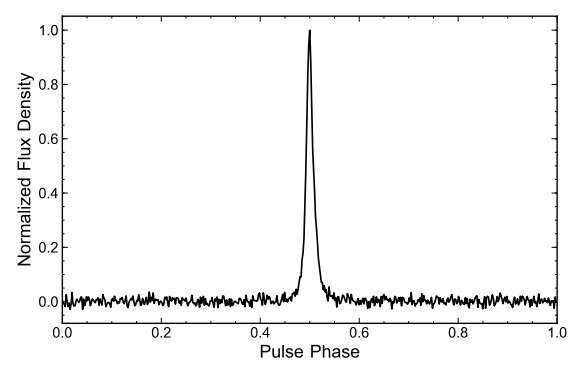Pulse profile for PSR J2055+3829 at 1.4 GHz, formed by integrating 48.8 hr of coherently dedispersed observations with the Nançay Radio Telescope and the NUPPI backend. Credit: Guillemot et al., 2019.
By conducting timing observations, astronomers have uncovered important insights into the properties of the millisecond pulsar PSR J2055+3829. Results of the observations, presented in a paper published July 23 on arXiv.org, indicate that this object is an eclipsing "black widow" pulsar.
The most rapidly rotating pulsars, those with rotation periods below 30 milliseconds, are known as millisecond pulsars (MSPs). It is assumed that they are formed in binary systems when the initially more massive component turns into a neutron star that is then spun-up due to accretion of matter from the secondary star.
A class of extreme binary pulsars with semi-degenerate companion stars is dubbed "spider pulsars." These objects are further categorized as "black widows" if the companion has extremely low mass (less than 0.1 solar masses), while if the secondary star is heavier they are called "redbacks."
Discovered in 2017 by the Nançay Radio Telescope (NRT), PSR J2055+3829 is an MSP with a rotational period of approximately 2.09 milliseconds and a dispersion measure of about 91.9 parsecs/cm3. It has a low-mass companion in a tight 3.1-hour orbit.
Now, a team of astronomers led by Lucas Guillemot of University of Orléans in France, unveiled new findings regarding the properties of this pulsar. Using NRT, the researchers performed timing observations of PSR J2055+3829, mainly at 1.4 GHz, which allowed them learn more about the nature and class of this object.
"We report on the timing observations of the millisecond pulsar PSR J2055+3829 originally discovered as part of the SPAN512 survey conducted with the Nançay Radio Telescope," the astronomers wrote in the paper.
According to the paper, the timing observations have identified eclipses of the pulsar's radio signal. In particular, at 1.4 GHz, the pulsar was found to be eclipsing for about 10 percent of the orbit, for a few minutes around superior conjunction of the system. These eclipses, asymmetric and variable, are most likely caused by the outflow of material from the companion.
The mass of the pulsar's companion was calculated to be most likely between 0.023 and 0.053 solar masses. Therefore, taking into account the companion's estimated mass, the presence pf radio eclipses, and the detection of time variations of the orbital period, the researchers classified PSR J2055+3829 as an eclipsing "black widow" pulsar.
The study found that the mass of the pulsar is most likely around 1.4 solar masses and that the both objects are separated by approximately 1.2 solar radii. By comparing the results with other studies, the researchers concluded that eclipsing "black widows" have in general higher mass functions than their non-eclipsing counterparts. They also try to explain what could be responsible for such trend.
"Larger inclinations could explain the higher mass functions of eclipsing BWs [black widows]. On the other hand, the mass function distributions of Galactic disk and globular cluster BWs appear to be consistent, suggesting, despite the very different environments, the existence of common mechanisms taking place in the last stages of evolution of BWs," the astronomers underlined.
More information: Timing of PSR J2055+3829, an eclipsing black widow pulsar discovered with the Nançay Radio Telescope, rXiv:1907.09778 [astro-ph.HE] arxiv.org/abs/1907.09778
© 2019 Science X Network
























